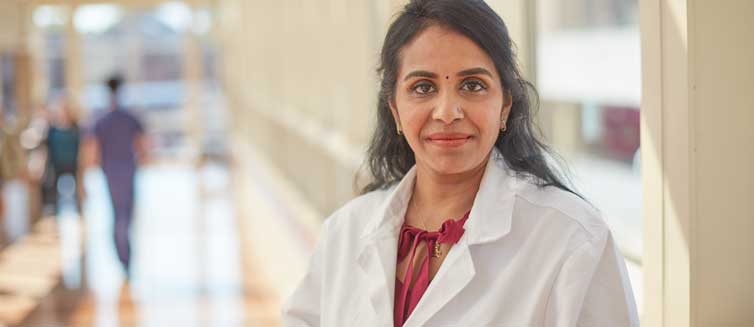On average, 1,500 people die each year waiting for a liver transplant.
As a result, living-donor liver transplant has become a powerful, lifesaving option. At times, it can be a confusing process. If you’re on the waiting list for a liver transplant or are thinking about donating, you will likely have questions.
Click Here to Learn More about Receiving a liver transplant. Contact UPMC.
Fill out the form below or call 833-683-3555 for more information.
We sat down with Swaytha Ganesh, MD, the medical director of UPMC’s Living Donor Program, to answer some of those questions.
UPMC has performed more liver transplants than any other transplant center in the country. And through our UPMC Complex Care Connect™ program, we extend our expertise to hospitals across the country. Learn more at the UPMC Complex Care Connect™ program website.
For the Donor
Q: Do living donors have to be related to the recipient?
A: No. If you’re thinking of donating or if you’re looking for a living donor, it’s important to remember that donors don’t have to be related. Potential donors can be anyone who meets the appropriate qualifications and has an unselfish desire to help. Donors can include family members, friends, spouses, coworkers, and neighbors.

Learn More About the Transplant Process.
Q: Who can be a living liver donor?
A: Donor safety is very important. Potential donors will be carefully evaluated to make sure it’s safe for them to donate and confirm they are the best medical match for the recipient. A potential donor must:
- Be between the ages of 18 to 54
- Have a BMI less than or equal to 32
- Not engage in ongoing drug or substance use
- Be in good general health with no history of HIV, pulmonary hypertension, liver disease (including cirrhosis and hepatitis B or C), active cancers, or other significant diseases involving the lungs, heart, or kidneys.
Q: I have heard that the liver can regenerate. Is that true?
A: Yes. The liver has the unique ability to regenerate, or regrow, back to normal size within a few months after surgery. Because of this, living donation is a lifesaving option for those needing a liver transplant.
Q: How much of my liver is removed?
A: The percentage of the liver that’s removed from the donor depends on the age and size of the person receiving the transplant. Typically, with adult-to-adult donation, about 50 to 60 percent of the liver is removed from the donor and transplanted into the recipient. If you’re donating to a child, about 25 percent of the liver is removed.
RELATED: Life After Receiving a Liver Transplant
Q: Do I need to have the same blood type as the recipient to donate?
A: No. Having a compatible blood type is no longer required.
Q: How long does it take for a donor to recover from a transplant?
A: Once donors are discharged from the hospital, they typically return to their normal daily activities, including showering and getting dressed, within about one week. Most donors can return to work within six to 12 weeks; after three months, donors tend to be back to their former level of health. However, throughout the recovery process, you will return to the hospital for routine check-ups.
To register to be a living donor and save a life, please visit UPMC Transplant Services.
For the Recipient
Q: How do I know if I am eligible to receive a liver transplant?
A: At UPMC Transplant Services, you will go through a series of evaluations to determine if you’re a candidate for liver transplant. You will need to bring a caregiver with you to these evaluations. A caregiver can be any loved one who will provide support throughout the transplant experience.
For more information regarding liver transplant evaluations and what to expect as a potential recipient, please visit the UPMC Transplant Services website.
Q: If I was turned down from another center, will UPMC still evaluate me?
A: Even if you have been turned down by other centers, our experts will review you. While we can use results from testing at other transplant centers, we ask that you be reviewed by our doctors.
Q: Who is a part of UPMC Transplant Services? Will I have help and support as I go through the process?
A: The UPMC liver transplant team will guide and work with you every step of the way. The team consists of a:
- Transplant nurse coordinator
- Transplant surgeon
- Living donor advocate
- Transplant hepatologist
- Transplant psychologist
- Transplant social worker
- Transplant nutritionist
- Transplant pharmacist
Q: How often are follow-up appointments after liver transplant surgery?
A: Follow-up depends on your rate of recovery. To ensure the best outcome possible, most patients visit UPMC’s post-transplant clinic:
- Once a week for the first month
- Once every two weeks after two months
- Once a month after six months
Your doctor will determine how often you’ll need to visit after nine months.
For more information about living donation, contact the UPMC Liver Transplant Program at 412-647-5800 or email transplant@upmc.edu.
Join the conversation about living donation. Like us on Facebook today.
Never Miss a Beat!
Subscribe to Our HealthBeat Newsletter!
Thank you for subscribing!
You can now select the specific newsletters you'd like to receive.
You are already subscribed.
Subscribe to more newsletters in our email preference center.
Sorry, an error occurred. Please try again later.
Get Healthy Tips Sent to Your Phone!
About Transplant Services
For more than four decades, UPMC Transplant Services has been a leader in organ transplantation. Our clinicians have performed more than 20,000 organ transplant procedures, making UPMC one of the foremost organ transplant centers in the world. We are home to some of the world’s foremost transplant experts and take on some of the most challenging cases. Through research, we have developed new therapies that provide our patients better outcomes — so organ recipients can enjoy better health with fewer restrictions. Above all, we are committed to providing compassionate, complete care that can change – and save – our patients’ lives. Visit our website to find a provider near you.
